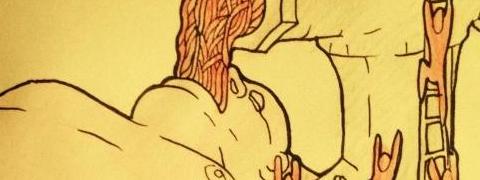[dropcap style=”font-size:100px; color:#992211;”]G[/dropcap]et up, calmly push your chair back, gather your favourite things. Affect a sanguine countenance and walk promptly to the door.
No job is worth saliva sampling, drug testing or humiliation. Yes, they’ll dress it up as an initiative to identify and protect employees from harmful stress. Of course they will. Like 18th century industrialists put in safety guards to stop all those millworkers from gumming up the machines with their pesky severed limbs.
Come back Bob Crow, you’re needed here.
Your answers on psychological questionnaires, including some of the ones that some employers give their employees, might have a distinct biological signature.
New research indeed demonstrates overlap between what workers feel and what their bodies actually manifest. This is an important occupational health issue when we consider that workplace stress is the leading cause of sick leave related to depression and burnout. Involving over 400 workers from 35 businesses, the research was conducted by the researchers at the University of Montreal, its affiliated Institut universitaire en santé mentale de Montréal, and McGill University.
)
Stay sharp
“Our goal in this study was to see if responses on self-reported questionnaires would correspond with concentrations of the stress hormone cortisol”, says Alain Marchand, professor at University of Montreal and researcher at its Public Health Research Institute. Easily collected and analyzed from saliva samples, cortisol is a powerful hormone that is secreted under conditions of stress as part of the “fight-or-flight” response in addition to its normal day-to-day peaks and dips that are part of our circadian rhythms that help us stay sharp.
“Cortisol is adaptive, as it has evolved to provide us the energy we need to survive,” says Sonia Lupien, Director of the Centre for Studies on Human Stress at the Institut universitaire en santé mentale de Montréal and professor at the University of Montreal. “The problem is that in modern societies, our brain does not make the difference between a mammoth and a stressful boss. Because Mother Nature preserves what works well, the same system is activated and can become damaging when chronically activated.”
Symptoms of depression and burnout
The research group asked workers to fill out questionnaires on psychological distress, depression, and burnout, followed by collection of saliva at different time-points throughout work and non-work days. Across the board, their results published in the Scandinavian Journal of Work, Environment & Health showed that increased self-ratings of distress and symptoms of depression and burnout on questionnaires were associated with distinct cortisol profiles depending on the time of the day.
For example, severe psychological distress and depressive symptoms were associated with the highest levels of cortisol. By contrast in a separate analysis focusing on specific burnout sub-types published in Psychoneuroendocrinology, the authors found that severe burnout and emotional exhaustion were associated with low levels of cortisol thirty minutes after awakening.
Fatigued workers simply cannot mobilize the energy necessary to function optimally
“In contrast to depression, risk for burnout might be related to sluggish cortisol concentrations as fatigued workers simply cannot mobilize the energy necessary to function optimally”, says Robert-Paul Juster, a doctoral student at McGill University who is researching at the Centre for Studies on Human Stress at the Institut universitaire en santé mentale de Montréal.
“This study pushes the envelope in preventative application by showing that workers’ subjective psychological experiences are indeed related to objective biological signatures that differ from a normal profile as well as from one psychological condition to another”, says Pierre Durand, a co-author of the study and member of the research group at the University of Montreal’s Public Health Research Institute and School of Industrial Relations.
“The strength of our study is our large and representative sample that allowed us to account for variability between workplaces to maximize our understanding of what cortisol looks like in distressed workers”, says Marchand. The researchers believe that combining information obtained from questionnaires along with biological measures is a promising approach to better understand how subjective measures of the “mind” map onto objective measures of the “body” together.
This could in turn help recalibrate questionnaires as screening tools that would help mental health professionals identify and help workers better cope before it is too late.
Source: University of Montreal
Illustration by Dan Booth. Not to be reproduced without his express prior permission

Some of the news that we find inspiring, diverting, wrong or so very right.























After a hard day of work, or before even, just go up in the bell tower and shoot 30 people. Brings the stress level right down.